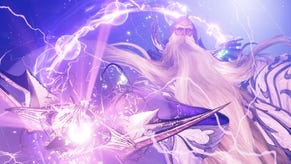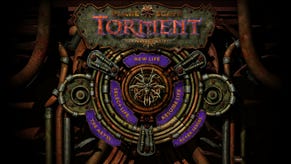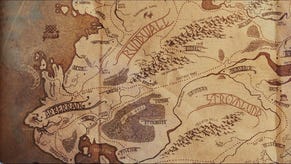Post-Planescape: Fargo Reveals The Future Of Torment
What can change the nature of a sequel?
Rumours have been swirling for years about a possible sequel to Black Isle's legendary and powerful roleplaying game Planescape: Torment, but the closure of the original studio and the jealous guarding of the Planescape rights by owners Wizards of the Coast seemed to have put paid to any comeback. But with original Interplay boss Brian Fargo very much back in the RPG business with current studio inXile's wildly successful Wasteland 2 crowdfunding, everything changes. He and his team have come up with a way to make a new Torment game: this is really happening.
And there was much rejoicing.
Read on for details of its new setting, the people involved, whether it'll link to the original game, which thematic aspects will recur, how the combat may work and how they'll get it made.
First up, the new setting for this new Torment will be Numenera, an original roleplaying setting and system created (and recently Kickstarted by) Monte Cook, a contributing writer/designer on the original Planescape pen and paper RPG and assorted other Wizards of the Coast projects. A mix of fantasy and sci-fi with a strong focus on storytelling freedom, it may not be Planescape but hopefully it offers an appropriate blend of liberty and strangeness for a new Torment game. Have a look at its site for fulsome details of what's planned for it. Here, meanwhile, inXile boss Brian Fargo sheds a whole lot of light on what the partnership means for his studio's Torment sequel.
RPS- I know he revealed it back in August and seemed to have a ton of groundwork done already, but is Monte Cook's Numenera setting being designed with a Torment game in mind to any extent? Will you guys have a chance to shape his plans for that as you'll be working together?
Fargo: The wheels for the Torment game have been in motion for quite some time. The more we explored the Numenera setting, the clearer it became that it’s a natural fit for a Torment game. And it isn’t too surprising that Numenera’s aesthetics work well for Torment given that Monte was a key designer for the Planescape setting.
Numenera is very exotic and rich, but is a flexible universe that empowers and support GMs. As Torment desires certain locations or features, we’ll be able to do what we need to while fully respecting the setting. This goes beyond a typical licensing arrangement as Monte will be giving us direct input and even provide writing for some of the game areas. I'm really pleased to have Monte be part of the team.
RPS - What are the stand-out aspects of Numenera for you, in terms of suiting your dev plans? How much is about the setting and how much the roleplaying mechanics?
Fargo: A Torment game requires big ideas and a truly exotic setting in order to explore the underlying thematic elements. Colin described it best when he said “Torment’s themes are essentially metaphysical, getting to the heart of what it means to be alive and conscious, and it's easier to ask those questions in a setting that is far removed from the familiar.” Numenera is such a setting, and it has tremendous potential to cultivate those ideas. We won’t have faeries or devils, but we’ll have diabolical creatures from far dimensions with schemes beyond human imagination. We won’t have gods, but we’ll have creatures who have lived for millennia with the powers of creation and destruction at their fingertips, with abilities honed over countless lifetimes. We won’t have other planes per se, but we’ll have pathways to hostile worlds and bizarre landscapes and ancient machines that catapult the players into places where the ordinary laws of nature no longer apply. In terms of role-playing mechanics, we won’t be attempting to literally translate the Numenera tabletop system into electronic form. However, its gameplay mechanics are very solid and include several components that will lend themselves to great (and innovative) cRPG gameplay. It’s great to have the Numenera rules as a starting point and to be working with Monte to adapt them for a cRPG.

RPS - Given no Planescape and presumably none of the PST characters, what makes a Torment game a Torment game to your mind?
Fargo: We know it hasn't been done often in the game industry, but we're envisioning Torment as a thematic franchise with certain themes that can expand over different settings and stories. We will focus on the same things that made people appreciate PST so much: overturning RPG tropes; a fantastic, unconventional setting; memorable companions; deep thematic exploration of the human condition; heavy reactivity (i.e., choice and consequences); an intensely personal (rather than epic) story.
RPS - How much are you thinking of working in overt links to/echoes of PST as opposed to broader thematic commonality? And what are the legal restrictions there - for instance, if you wanted to include a smartass talking skull with a dark secret, could you include a smartass talking skull with a dark secret?
Fargo: Rather than overt links, we are trying to recapture the feeling that players experienced through PST –both while playing it and after having completed a playthrough. We will remain true to the essence of PST, but we’ll also be looking for ways to improve the areas in which PST could have been even better. Fortunately, besides our personal experiences, we have years of feedback from other passionate PST fans to draw upon. We certainly would not infringe on any copyrights but with that said there are very few elements in RPGs that can be protected. There are several games with talking skull heads, for example, if we wanted to incorporate things of that nature.

RPS - Where are inXile up to in terms of designing this thing, given you've presumably incredibly busy with Wasteland? Will you be working on it concurrently with Wasteland or saving it for later?
Fargo: We’re very early in Torment’s preproduction right now. We have a basic story outline, design sketches of the major characters, and thematic concepts defined. Wasteland 2 is in full production and we don’t want to detract from that focus. But with that said, the writers on Wasteland are complete for the most part and the concept artists are not involved at this stage in the game. The guys working on Torment are no longer working on Wasteland 2 and I want to keep these talented guys busy for us. Typically we do begin design of the next game while the production team is working on the current one. This allows the team to take a nice break once they are complete on the current game and then come back to roll onto a design that is thorough and polished. The last thing we want to do is break up a winning team.
I find this model creates a better quality flow of product and doesn’t have the team jumping onto a sequel before there has been adequate time to absorb the feedback from the game that just shipped. It is a luxury that most mid size developers are not able to have and it allows the time required to create classics. I never like sequels to be rushed and working this way ensures the team works on fresh ideas.

RPS - While PST was a team effort Avellone's become the poster boy for it since release - so, have you been thinking/talking about getting him involved? And if you can't for any reason, do you have a plan on how to convince the PST faithful that is a true-blue Torment?
Fargo: Chris deserves all the credit that he receives and we are working with him on Wasteland 2 as you know. My role as executive producer is to assemble top notch teams and to make sure we stay on point for what we are creating. I'm really happy with the team we have assembled for this game. It was Chris who urged me to work with both Colin McComb and Kevin Saunders for this project and he has given us his blessing for another Torment. Colin McComb and Monte Cook were two of the primary developers of the Planescape campaign setting for TSR, and Colin was one of the main designers on the original Torment. Colin serves as creative lead for this Torment and will be driving the story vision for the game.
Kevin Saunders, the project director, worked with Chris at Obsidian for 5 years – including leading the Mask of the Betrayer (MotB) team. People might remember that MotB was very well received and there were more than a few comparisons to PST. Kevin was also the lead designer and producer for Shattered Galaxy, which swept the 2001 Independent Games Festival and was acknowledged by GameSpot as the Most Innovative Game of the year.
Additionally, we have one of the unsung heroes of PST on the design team: scripter Adam Heine, who really helped breathe life into the game. He was also one of the designers on Black Isle's TORN, having moved to that position in large part because of his excellent work on PST.
Our talented artists include Dana Knutson, the concept artist from the original Planescape campaign setting, and he’s been helping bring our ideas to life.
And to really show we are serious about the writing aspects of this game we brought Ray Vallese in as the editor to ensure the detail and consistency of the story. Ray too was part of the Planescape team at TSR.
There will be some other surprise talent that I'll announce later on but I thought it important to stress the heritage of the great team we have. I feel quite confident that the players of PST will feel comfortable and appreciate the experience being created.

RPS - Real/pause time or turn-based?
Fargo: I’ll let the producer Kevin Saunders answer that one: “The details of combat are still an open question, but our initial leaning is that real-time with pause will provide the better experience for the game. Whichever direction we ultimately take it, we’ll be giving combat considerable attention – we are aware that one of the criticisms of PST (including from Avellone) was its combat and we want to improve upon that aspect. The Numenera combat system provides a stronger starting place for a cRPG than AD&D 2nd Edition did and we’ll prototype early so that we have ample time to iterate over the course of the project. We are also working on ways to weave narrative elements into the combat system such that the gameplay and story complement each other. But I should mention that even while enhancing combat, we will stay true to PST by making it so players can almost completely avoid battles based upon their choices.”

RPS - Are you thinking Kickstarter again?
Fargo: Absolutely. There are obvious advantages to Kickstarter for both developers and backers. We get our games funded without dealing with a crazy publisher and the backer gets a game for much less than what the finished product would cost non-backers. But beyond that, the benefit of crowd funding is that it provides feedback and accountability to the people who are actually going to play the game. It validates the concept and helps us prioritize the sensibilities of the project. We are not forced to compromise for the thought of how the “mass market” might react. It’s a wonderfully pure process and one that hinges on trust.
RPS - Can you talk about why Wizards of the Coast were resistant to licensing Planescape again?
Fargo: We asked and were rebuffed. In reality we didn’t push very hard on licensing it as the team was excited to work with Monte on Numenera and they felt that there would be less creative restriction. And WotC has been pretty silent on this space for some time. Neither Feargus nor I was able to get a Baldur’s Gate 3 project going.
RPS - Did you meet any resistance when seeking the Torment name?
Fargo: I patiently waited for someone to do something with a Torment concept but nothing happened. After many years the rights expired and allowed me to step in and put together a great team to make another title of its kind. We will improve on the mechanics and deliver a deep narrative story that is deserving of the name Torment.
RPS - Thanks for your (pause-)time.

















